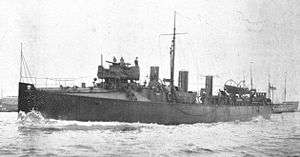Sunfish-class destroyer
 HMS Ranger | |
| Class overview | |
|---|---|
| Name: | Sunfish class |
| Builders: | Hawthorn Leslie, Hebburn |
| Operators: |
|
| Preceded by: | Handy class |
| Succeeded by: | Rocket class |
| Built: | 1894–1896 |
| In commission: | 1896–1920 |
| Completed: | 3 |
| Scrapped: | 3 |
| General characteristics | |
| Type: | Torpedo boat destroyer |
| Propulsion: | 8× Yarrow boilers, 4,000 hp (2,983 kW) |
| Speed: | 27 knots (50 km/h; 31 mph) |
| Complement: | 53 |
| Armament: |
|
The Sunfish-class destroyers, also referred to as Opossum-class destroyers,[1] was a group of three torpedo boat destroyers which served with the Royal Navy from the 1890s to the 1920s. They were all built by the Hebburn-on-Tyne shipyard of Hawthorn Leslie.
Design
Powered by 8 Yarrow boilers,[2] this was the same 8 boiler configuration originally used on HMS Hornet.[3] The ships produced 4,000 hp (3,000 kW) and could make 27 knots (50 km/h; 31 mph). They were armed with one twelve pounder gun and two torpedo tubes and carried a complement of 53 officers and men.
History
Ordered under the 1893-94 Programme, the contract was placed on 7 February 1894. All three "turtle-back" destroyers were laid down in 1894, launched in 1895 and completed in 1896.
In 1912 all three, like the other surviving 27-knotter destroyers, were re-classed as A-class destroyers. They served in Home waters throughout the First World War, and all three were sold for breaking up in 1920.
Ships in class
- HMS Sunfish
- HMS Opossum
- HMS Ranger
References
Notes
- ↑ "Opossum Class British Destroyers". worldnavalships.com. Retrieved 25 May 2010.
- ↑ Lyon, The First Destroyers, p. 92
- ↑ Lyon, The First Destroyers, p. 54
Bibliography
External links
| Wikimedia Commons has media related to Sunfish class destroyer. |